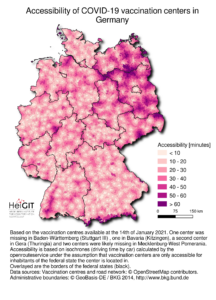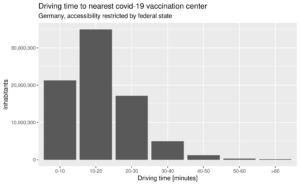Updated based on newly available vaccination center locations at the 14th of January 2021.
Vaccination of a sufficiently large share of the population is considered the most important action to fight the spread of SARS-CoV -2 and resulting COVID-19 infections. Germany has started together with the majority of EU member states at the 27th of December 2020 its vaccination campaign. After an initial phase in which mobile teams vaccinate inhabitants of home for the elderly as well as stuff in homes for the elderly and hospitals vaccination centers will be in charge of vaccinating the population. The vaccination centers will later on presumably supported by vaccination by medical practitioners. Till when, easy access to the vaccination centers is one important factor for a successful vaccination campaign. Access to vaccination is by appointment – the procedures differ between the individual federal states.
Most federal states in Germany have announced the location of the vaccination centers. The OpenStreetMap community has immediately added this information to its data base – details can be found in the corresponding OSM Wiki page. One center was missing in Baden-Württemberg (Stuttgart III) , one in Bavaria (Kitzingen), a second center in Gera (Thuringia) and two centers were likely missing in Mecklenburg-West Pomerania.
We at HeiGIT have used this information to calculate the accessibility to these centers by means of the openrouteservice. Based on its isochrones functionality we calculated the time required to reach the centers by cars. We distinguished two cases:
- unconstrained access to the vaccination centers
- access constrained by federal state – i.e. we assumed that only inhabitants of the federal state that host the vaccination center are allowed to access the center
The map of driving distances indicates that while large parts of Germany have access to the vaccination centers in reasonable driving distances some regions have to face longer driving distances. These are located in less densely populated areas. Please keep in mind that that a few vaccination centers could not be located so far.

Overall ~27% of inhabitants in the federal states live in driving distance of 10 minutes or less, ~70% in driving distance of 20 minutes or less and 91.6% in driving distance of 30 minutes or less. However, this implies that 6.8 million inhabitants have to face a driving time of more than 30 minutes from which ~190,000 inhabitants have to drive more than one hour – one way.

If we look at the individual federal states separately we see an uneven distribution of driving time: especially inhabitants of Brandenburg will have to undertake relatively long journeys to the next vaccination center in the federal state since 43.8% of the inhabitants are living in a driving distance of more than half an hour, from which 4.7% are living farther away than 50 minutes. Inhabitants of Mecklenburg-West Pomerania presumably will also have to face longer average driving distances.
If vaccination centers could also serve inhabitants of other federal states driving distances especially in Brandenburg and Mecklenburg-West Pomerania would improve (results not shown).

You might also be interested in our analysis of accessibility to pharmacies in Germany with 15km covid-19 restriction,
Some of our earlier work on healthcare / accessiblity using OSM:
- Mapping physical access to health-care for older adults in sub-saharan-africa and implications for the covid-19-response – a cross-sectional analysis
- Exploring OSM for healthcare access analysis in Sub-Saharan-Africa
- OSM-Completeness of health-facilities in Sub-Sahara-Africa
- Recent changes to openstreetmap healthcare infrastructure in India
- New jupyter notebook: Analysis of access to health-care using openrouteservice isochrones-api-2
- Exploring OSM history – the example of health related amenities
- Quota for openrouteservice multi-vehicle-optimization increased to support logistics during corona-crisis
- Data-journalism-webapp about accessibility in sweden according to corona travel recommendations
- 25-mapathons: online-mapathon at humanitarian congress
- HeiGIT participates at virtual HOT-Summit-2020
- Healthsites.io and HeiGIT establish partnership


